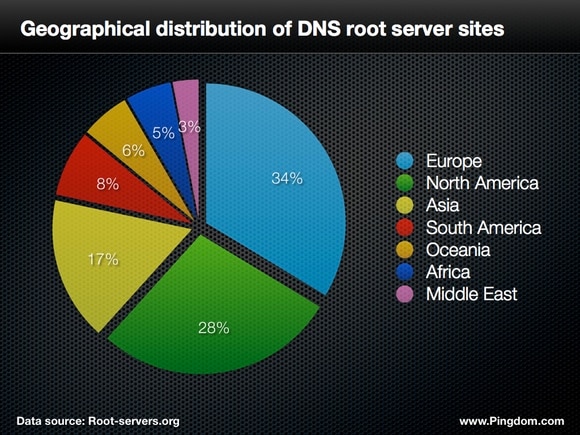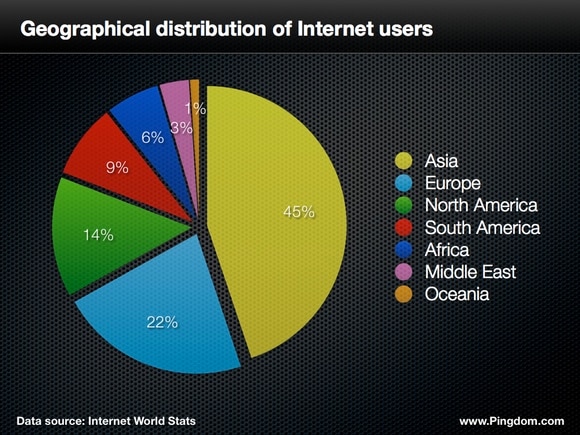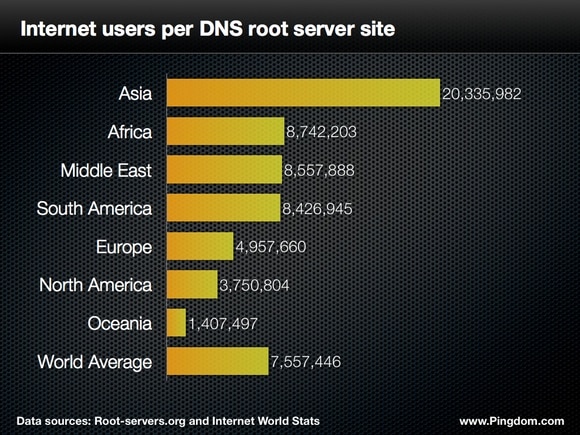
As we reported last Friday, the number of DNS root servers on the Internet has grown significantly the past few years. Now we will take a closer look at how those root servers are distributed across the world.
Since the root servers are critical to Internet’s DNS infrastructure, they would ideally be spread out in a way that serves the Internet population in a fair and even manner. That is, however, not the case.
As you’ll see, when you start taking regional Internet user numbers into consideration, the distribution of root servers is highly uneven. Some regions are clearly underserved.
DNS root server distribution
First, let’s have a look at the actual distribution of the world’s root servers. We have grouped them by world region, so you can get a good overview:

Higher-res png version available here.
So, that’s how the root servers are distributed. Now compare that with the distribution of Internet users across the same regions. We have kept the colors for the regions the same, so you can easily compare the two charts.

Higher-res png version available here.
It’s not hard to see that there are some staggering differences here. One would imagine that if all things were equal, the distribution of root servers should mirror the distribution of Internet users. But it’s not even close.
Here are a couple of the most blatant discrepancies:
- Europe and North America together have only 36% of the Internet population, but 62% of the root servers.
- Asia has 45% of the Internet population, but only 17% of the root servers.
Clearly Asia is getting the short end of the stick.
Internet users per root server
To further illustrate the differences in root server distribution, you can look directly at how many Internet users there are for each root server site in a region. The lower the number, the better.

Higher-res png version available here.
There is a lot you could say about this, but we’ll settle for a few observations.
- Asia, worst off by far, has more than 5 times as many Internet users per root server as North America.
- Oceania, consisting mainly of Australia and New Zealand, is in the best shape of all the regions based on this metric.
We also included the world average so you could have a reference point. You can see how the world is divided in two parts here:
- Above average (a bad thing in this case): South America, Middle East, Africa, Asia.
- Below average (a good thing in this case): Europe, North America, Oceania.
Trends
An interesting side note is that in 2007, the world average was 9.4 million Internet users per root server site. In 2012 it is, as you can see in the chart above, 7.6 million. That is definitely an improvement.
Asia on the other hand has gone from 16.7 million Internet users per root server site in 2007 to 20.3 million in 2012.
In other words, the world as whole is getting a better ratio between the number of Internet users and root servers, while Asia is getting a worse ratio.
In the past 5 years the world Internet population has doubled, and more than half of the new Internet users have come from Asia. It’s clearly a region that is becoming increasingly underserved in terms of DNS infrastructure.
Conclusion
The overall distribution of root servers is much better than it was a decade ago. There are more of them, in more locations, and the hardware involved is more powerful. However, the distribution of root servers seems to have taken a wrong turn at some point, not matching its growth to how the Internet population is spread out.
To some extent you can probably blame this on the general state of the Internet’s infrastructure. The more “developed” regions, with more established infrastructure, are better off. However, the differences are so large that that is unlikely to be the only reason.
We think that the root server distribution should take regional Internet population size into consideration, so we hope the people in charge read this and act accordingly as the Internet continues to grow.
Data sources: Root-servers.org and Internet World Stats.
Image credit: Top image via Shutterstock.
























